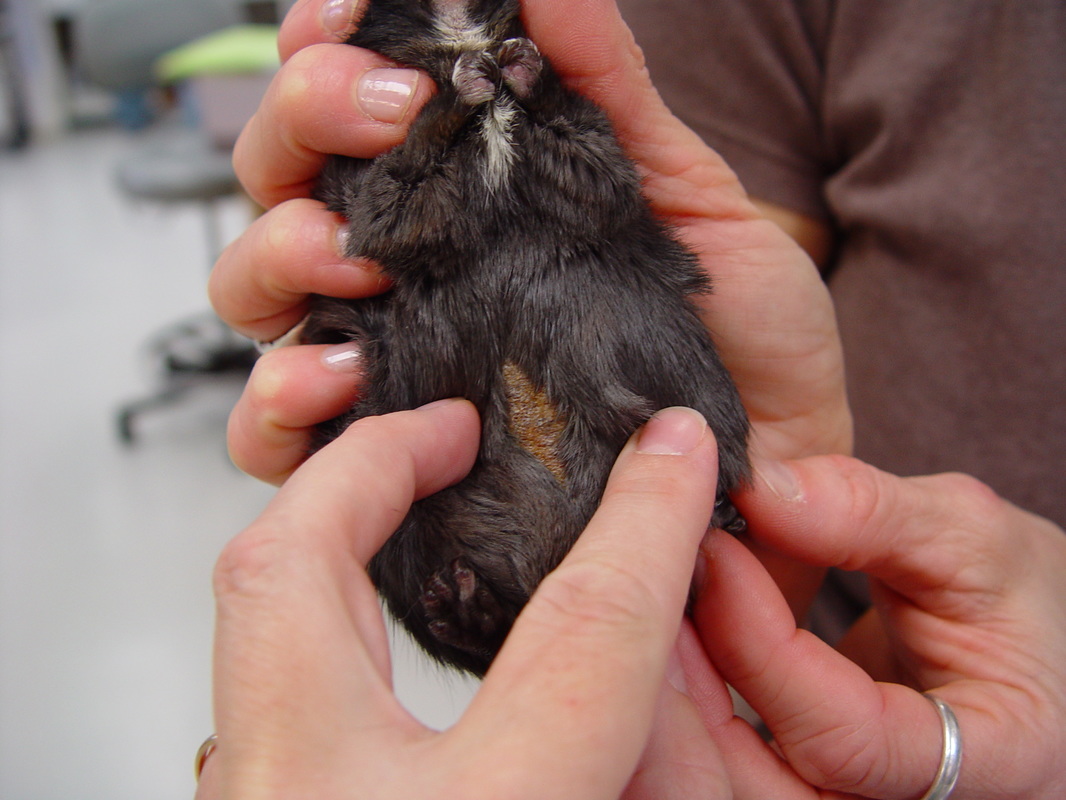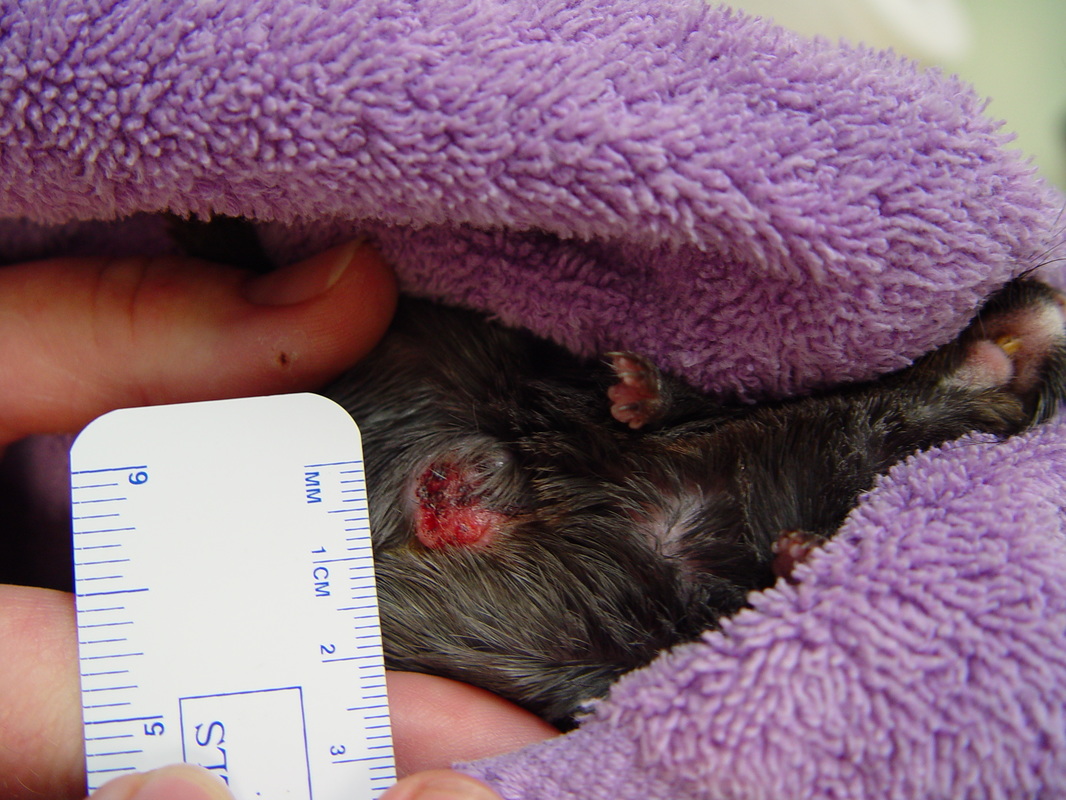Gerbil Care
Adapted from "Taking Care of your Gerbil" by Susan Leck, DVM, Dipl ABVP
Photos and edited by Susan Horton, DVM
Photos and edited by Susan Horton, DVM

Of the numerous gerbil genera world wide, the Mongolian gerbil (Meriones unguiculatus) is the prevalent pet species in the United States. Mongolian gerbils are native to desert regions of Mongolia and northeastern China. They are active both day and night, but peak activity occurs at night. They are social animals that live in elaborate underground tunnel systems and burrows.
All pet gerbils are captive bred for this market. They make appropriate pets for beginners, and their natural curiosity makes them interesting to watch as they explore their environments.
Gerbils are available in a variety of color types: agouti (the free-ranging type or normal color), black, albino, white, cinnamon, lilac, blue cream, silver and sable. Spotted gerbils with multiple coat colors are also popular.
Pet Potential
Gerbils tend to be friendly, clean, quiet and curious pets. They rarely bite and can be easily handled. They produce minimal odor and only small amounts of waste. Their small size means those space requirements are not excessive. With proper husbandry, gerbils rarely exhibit problems in captivity.
Housing
The minimum cage size should be 36 square inches per gerbil; a breeding pair requires a minimum of 180 square inches. Cage sides should be at least 6 inches high, and the enclosure should otherwise be escape-proof.
Plexiglas enclosures designed for small rodents make adequate houses for gerbils; however, regular cleaning schedules must be maintained because this solid-sided caging (as opposed to wire) will trap ammonia from urine. A split tank is an ideal way to introduce gerbils to each. Solid flooring is preferable to wire flooring. Bedding should be clean, dry, absorbent, nonabrasive and at least 2 cm deep to facilitate nesting behavior. We recommend Care Fresh, which can be purchased at your local pet store. A hiding place or hiding box should be provided in the cage. A bowl with a small amount of sand or chinchilla dust should be provided for 10-15 minutes several times a week for sand baths.
Natural sunlight is beneficial to all creatures, but gerbils must not become overheated. They survive desert temperatures by burrowing underground. An acceptable lighting schedule consists of 12-hour alternating light and dark cycles.
All pet gerbils are captive bred for this market. They make appropriate pets for beginners, and their natural curiosity makes them interesting to watch as they explore their environments.
Gerbils are available in a variety of color types: agouti (the free-ranging type or normal color), black, albino, white, cinnamon, lilac, blue cream, silver and sable. Spotted gerbils with multiple coat colors are also popular.
Pet Potential
Gerbils tend to be friendly, clean, quiet and curious pets. They rarely bite and can be easily handled. They produce minimal odor and only small amounts of waste. Their small size means those space requirements are not excessive. With proper husbandry, gerbils rarely exhibit problems in captivity.
Housing
The minimum cage size should be 36 square inches per gerbil; a breeding pair requires a minimum of 180 square inches. Cage sides should be at least 6 inches high, and the enclosure should otherwise be escape-proof.
Plexiglas enclosures designed for small rodents make adequate houses for gerbils; however, regular cleaning schedules must be maintained because this solid-sided caging (as opposed to wire) will trap ammonia from urine. A split tank is an ideal way to introduce gerbils to each. Solid flooring is preferable to wire flooring. Bedding should be clean, dry, absorbent, nonabrasive and at least 2 cm deep to facilitate nesting behavior. We recommend Care Fresh, which can be purchased at your local pet store. A hiding place or hiding box should be provided in the cage. A bowl with a small amount of sand or chinchilla dust should be provided for 10-15 minutes several times a week for sand baths.
Natural sunlight is beneficial to all creatures, but gerbils must not become overheated. They survive desert temperatures by burrowing underground. An acceptable lighting schedule consists of 12-hour alternating light and dark cycles.

Environmental Enrichment
Like all rodents, gerbils need to have safe materials for gnawing that will help wear down their continually growing incisor teeth. Wooden blocks are readily available at most pet stores for this purpose. An exercise wheel provides an outlet for energy, and plastic exercise balls allow the gerbil to explore while safely enclosed. Gerbils like to build nests out of nesting material, especially in the cooler winter months. A common characteristic of pet gerbils is their propensity to dig incessantly with their forepaws in the corner of the cage. They also thump with their hind legs.
Diet
Commercial pellet diets are available for gerbils. Alternatively, commercial seed mixes with a variety of seeds (minimal to no sunflower seeds) may be fed with fresh vegetables (e.g., collards, kale, broccoli stems, carrots, beets) and soaked seeds or sprouts. Alfalfa hay should be available for grazing and is a good calcium source for nursing females.
Excessive consumption of sunflower seeds and other high-fat foods will lead to obesity, elevated cholesterol levels and liver disease.
Even though gerbils are naturally desert-dwelling creatures and are very good at obtaining their fluid requirement from their food, fresh clean drinking water should always be available. A sipper tube or small water bottle mounted on the outside of the cage with the drinking spout on the inside is ideal in order to prevent chewing on the bottle.
What Every Owner Should Know About Gerbils
Like all rodents, gerbils need to have safe materials for gnawing that will help wear down their continually growing incisor teeth. Wooden blocks are readily available at most pet stores for this purpose. An exercise wheel provides an outlet for energy, and plastic exercise balls allow the gerbil to explore while safely enclosed. Gerbils like to build nests out of nesting material, especially in the cooler winter months. A common characteristic of pet gerbils is their propensity to dig incessantly with their forepaws in the corner of the cage. They also thump with their hind legs.
Diet
Commercial pellet diets are available for gerbils. Alternatively, commercial seed mixes with a variety of seeds (minimal to no sunflower seeds) may be fed with fresh vegetables (e.g., collards, kale, broccoli stems, carrots, beets) and soaked seeds or sprouts. Alfalfa hay should be available for grazing and is a good calcium source for nursing females.
Excessive consumption of sunflower seeds and other high-fat foods will lead to obesity, elevated cholesterol levels and liver disease.
Even though gerbils are naturally desert-dwelling creatures and are very good at obtaining their fluid requirement from their food, fresh clean drinking water should always be available. A sipper tube or small water bottle mounted on the outside of the cage with the drinking spout on the inside is ideal in order to prevent chewing on the bottle.
What Every Owner Should Know About Gerbils
- Prompt veterinary care should be sought for any sign of illness.
- Gerbils require a minimum of attention. Thirty minutes a day should be adequate in addition to the time needed to provide a safe, clean environment.
- Fresh food and water should be available at all times.
- The cage must be thoroughly cleaned at least weekly.
- Common household dangers include chewing electrical cords, children dropping or stepping on the gerbil, other pets (cats/dogs/ferrets are natural predators), eating toxic substances, gnawing inappropriate items and escaping or getting lost.
Pictured above on the left is a normal abdominal gland. The picture on the right is an abdominal gland that is abnormal. These glands can be the site of infection, hypertrophy, and even cancer. We can definitely help these guys even if the growth turns out to be cancer. Surgical removal, if done soon enough, is curative.

Gerbils can be easily trained to take medication from a syringe when needed. Some problems require life long medication such as heart disease. We have diagnosed heart disease in older gerbils.
 Luigi with splint
Luigi with splint
Pictured to the left is a gerbil named Luigi in his splint. Broken legs can be splinted to heal properly. We always recommend proper pain management as well!
If you have any questions, please feel free to call us at 847-329-8709.


